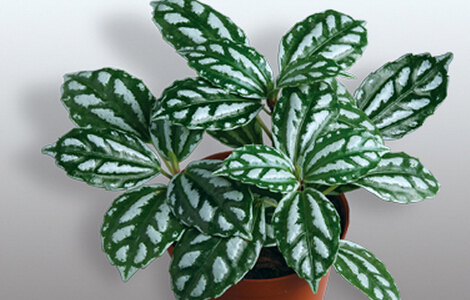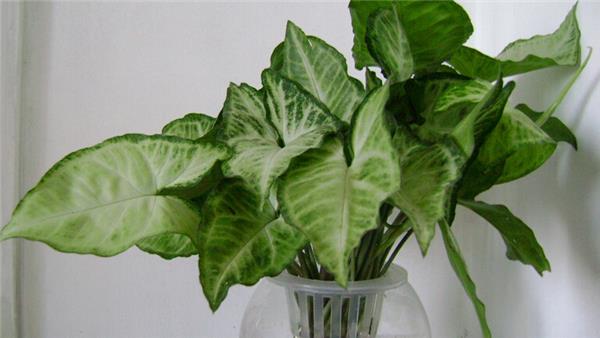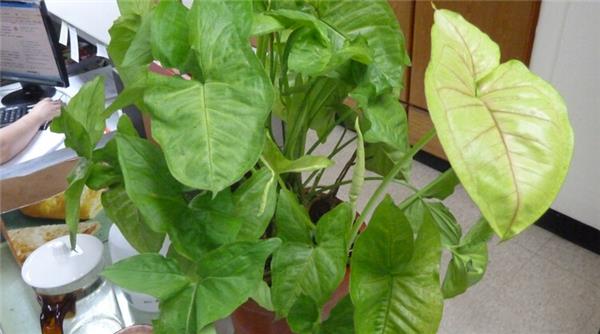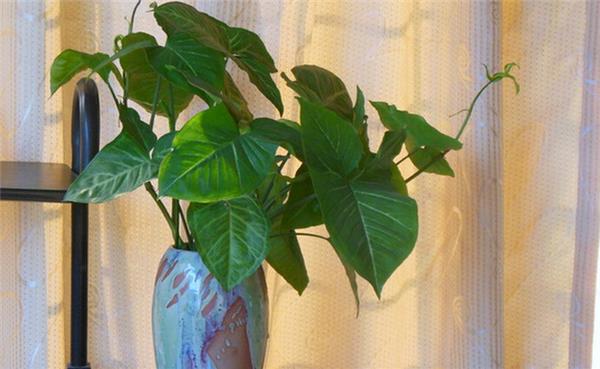Introduction to the culture methods and techniques of taro _ what to do if the leaves turn yellow?
Taro is a common indoor foliage plant, which is often used in indoor living room, study, window and other places. It is a very representative indoor plant. The plant state of taro is beautiful, the leaf shape is changeable and the color is clear and lustre, so it is very suitable for indoor potted plants, and green pineapple and vine green velvet are regarded as the representative indoor foliage plants of Araceae, and it is also a very popular indoor hanging basin decoration material in Europe and America.

Culture methods of synthetic taro:
1. Soil: fertile, loose and well-drained sandy loam is suitable for potted taro soil. Potted soil is a mixture of rotten leaf soil, peat soil and coarse sand.
2. Watering: the taro likes to be wet and afraid of dry. During the peak growth period in summer, it is necessary to fully water and keep the basin soil moist, so as to facilitate the rapid growth of stems and leaves. Increase foliar spray every day, maintain high air humidity, leaf growth is robust, substantial, with a better ornamental effect. When the water is insufficient or suffered from drought, the leaves become rough and smaller.
3. Sunshine: synthetic taro has strong adaptability, healthy growth, and can adapt to different light environment. In the strong light, the stem and leaves are slightly lavender, the leaves are larger and the color is light, while in the weak light, the leaves are narrow and dark. Grow well in bright scattered light. It is appropriate to shade 50% of the light. The color spots of variegated leaf varieties were not significant when the light was insufficient.
4. Temperature: the synthetic taro is not cold-tolerant. The suitable temperature for the growth of the synthetic taro is 22-30 ℃. It grows slowly at 15 ℃, and the stem and leaf stop growing below 10 ℃. Freezing injury occurred in leaves when the temperature was below 5 ℃ in winter.

5. Fertilization: dilute liquid fertilizer was applied every 1-2 weeks during the growing period of synthetic taro. Spray 0.2% ferrous sulfate solution once a month to keep the leaves green and lovely. If placed indoors, do not need to grow too fast, it is necessary to control the amount of fertilizer application. In order to increase the ornamental effect and make the white markings of leaves more significant, the application rate of nitrogen fertilizer can be reduced.
6. Insect pests: common leaf spot and gray mold of taro can be sprayed with 700 times of 70% zinc wettable powder. At ordinary times, it can be prevented by spraying the same amount of Bordeaux liquid. Whitefly and thrips are harmful to stems and leaves, which are sprayed with 1500 times of omethoate EC.
Is the taro poisonous?
As a plant of the genus Amorphophallus in the southern star family, the taro is poisonous, the main rhizome part is poisonous, the internal juice and dripping water are toxic, can not directly touch the plant, let alone eat, in case of eating, the juice will be splashed to the eyes, mouth, nose and other mucous membranes need to be cleaned with a large amount of water. Families with children had better not place a good impression.

Why do the leaves of taro turn yellow and lose their leaves?
Amorphophallus is native to the tropical rain forest, like high temperature and humidity, not cold-resistant; like semi-overcast, avoid strong light; when the environment is not reached, it will cause the leaves to turn yellow, or even die.
1. Soil alkalinity: taro should be planted in slightly acidic soil, while in most areas of northern China, the soil is neutral or alkaline. When using this kind of soil to cultivate taro, it will lead to the lack of iron elements that can be absorbed and utilized by plants in the soil. It is one of the main reasons for the yellowing of taro leaves.
2. Temperature harm: Amorphophallus likes high temperature and is not cold resistant. When the room temperature is below 10 ℃ in winter, the leaves will turn yellow due to low temperature damage. Indoor maintenance in winter, do not basin soil too wet, otherwise low temperature and more wet, will cause root decay or leaf yellowing fall off, affecting the ornamental value.
3, improper fertilizer: if too much watering, especially too much watering in winter, the basin soil is wet, especially it will cause rotten roots and cause taro leaves to turn yellow. In addition, insufficient fertilization, lack of nutrients, or long-term failure to change the basin or soil, the root system is crowded all over the basin wall, which hinders the development of new roots, which will cause leaves to turn yellow.

The above is about how to raise the taro and the method of yellowing the leaves of the taro. I hope it can help you. The arrangement of the green leaves of the taro is very lively at home, which can give people a refreshing and comfortable feeling, and the culture method of the taro is relatively simple, if you like to install potted plants indoors.
- Prev

Summary of cultivation skills of evergreen leaves and leaves what are the functions of evergreen
Summary of cultivation skills of evergreen leaves and leaves what are the functions of evergreen
- Next

Describe in detail the culture method of lotus flower _ how to make a healthy and beautiful lotus flower
Describe in detail the culture method of lotus flower _ how to make a healthy and beautiful lotus flower
Related
- Wuhan Hospital Iron Tree Blooming Result Was Instantly Frightened by the Gardener Master
- Which variety of camellia is the most fragrant and best? Which one do you like best?
- What is the small blue coat, the breeding methods and matters needing attention of the succulent plant
- Dormancy time and maintenance management of succulent plants during dormancy
- Minas succulent how to raise, Minas succulent plant pictures
- What are the varieties of winter succulent plants
- How to raise succulent plants in twelve rolls? let's take a look at some experience of breeding twelve rolls.
- Attention should be paid to water control for succulent plants during dormant period (winter and summer)
- Watering experience of twelve rolls of succulent plants
- Techniques for fertilizing succulent plants. An article will let you know how to fertilize succulent plants.

